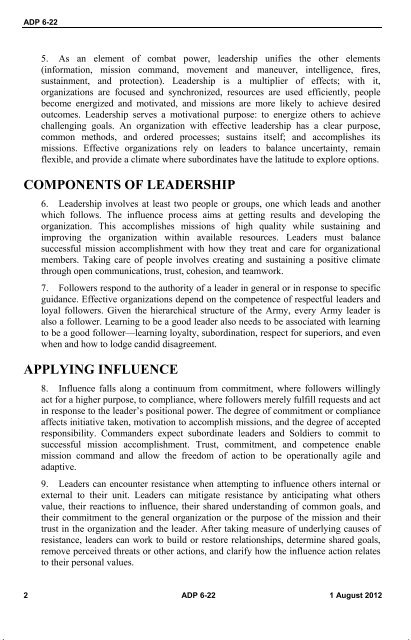ADP 6-22 - Army Electronic Publications & Forms - U.S. Army
ADP 6-22 - Army Electronic Publications & Forms - U.S. Army
ADP 6-22 - Army Electronic Publications & Forms - U.S. Army
Create successful ePaper yourself
Turn your PDF publications into a flip-book with our unique Google optimized e-Paper software.
<strong>ADP</strong> 6-<strong>22</strong><br />
5. As an element of combat power, leadership unifies the other elements<br />
(information, mission command, movement and maneuver, intelligence, fires,<br />
sustainment, and protection). Leadership is a multiplier of effects; with it,<br />
organizations are focused and synchronized, resources are used efficiently, people<br />
become energized and motivated, and missions are more likely to achieve desired<br />
outcomes. Leadership serves a motivational purpose: to energize others to achieve<br />
challenging goals. An organization with effective leadership has a clear purpose,<br />
common methods, and ordered processes; sustains itself; and accomplishes its<br />
missions. Effective organizations rely on leaders to balance uncertainty, remain<br />
flexible, and provide a climate where subordinates have the latitude to explore options.<br />
COMPONENTS OF LEADERSHIP<br />
6. Leadership involves at least two people or groups, one which leads and another<br />
which follows. The influence process aims at getting results and developing the<br />
organization. This accomplishes missions of high quality while sustaining and<br />
improving the organization within available resources. Leaders must balance<br />
successful mission accomplishment with how they treat and care for organizational<br />
members. Taking care of people involves creating and sustaining a positive climate<br />
through open communications, trust, cohesion, and teamwork.<br />
7. Followers respond to the authority of a leader in general or in response to specific<br />
guidance. Effective organizations depend on the competence of respectful leaders and<br />
loyal followers. Given the hierarchical structure of the <strong>Army</strong>, every <strong>Army</strong> leader is<br />
also a follower. Learning to be a good leader also needs to be associated with learning<br />
to be a good follower—learning loyalty, subordination, respect for superiors, and even<br />
when and how to lodge candid disagreement.<br />
APPLYING INFLUENCE<br />
8. Influence falls along a continuum from commitment, where followers willingly<br />
act for a higher purpose, to compliance, where followers merely fulfill requests and act<br />
in response to the leader’s positional power. The degree of commitment or compliance<br />
affects initiative taken, motivation to accomplish missions, and the degree of accepted<br />
responsibility. Commanders expect subordinate leaders and Soldiers to commit to<br />
successful mission accomplishment. Trust, commitment, and competence enable<br />
mission command and allow the freedom of action to be operationally agile and<br />
adaptive.<br />
9. Leaders can encounter resistance when attempting to influence others internal or<br />
external to their unit. Leaders can mitigate resistance by anticipating what others<br />
value, their reactions to influence, their shared understanding of common goals, and<br />
their commitment to the general organization or the purpose of the mission and their<br />
trust in the organization and the leader. After taking measure of underlying causes of<br />
resistance, leaders can work to build or restore relationships, determine shared goals,<br />
remove perceived threats or other actions, and clarify how the influence action relates<br />
to their personal values.<br />
2 <strong>ADP</strong> 6-<strong>22</strong> 1 August 2012

















